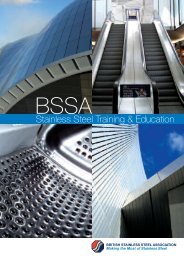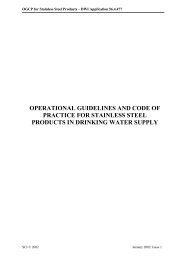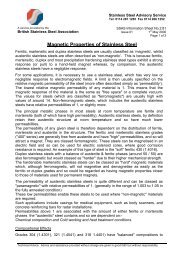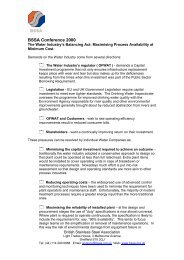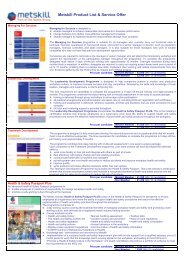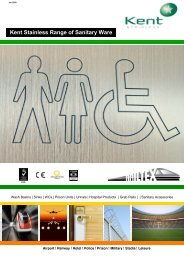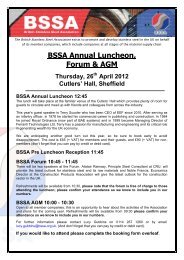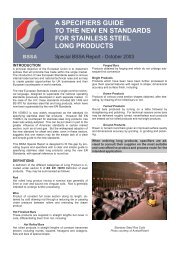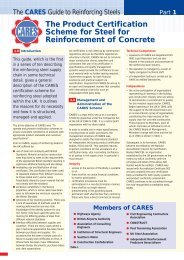The Welding of Stainless Steels - British Stainless Steel Association
The Welding of Stainless Steels - British Stainless Steel Association
The Welding of Stainless Steels - British Stainless Steel Association
Create successful ePaper yourself
Turn your PDF publications into a flip-book with our unique Google optimized e-Paper software.
<strong>The</strong> <strong>Welding</strong> <strong>of</strong> <strong>Stainless</strong> <strong><strong>Steel</strong>s</strong> – Defining the Skills Agenda<br />
1. Introduction<br />
Thank you for your kind introduction and for inviting me to speak this evening. I<br />
was pleased to read that the <strong>Welding</strong> & Joining Society is open to everyone with a<br />
practical, technical or business interest in welding, joining and the allied<br />
technologies. My knowledge <strong>of</strong> the practical aspects <strong>of</strong> welding is limited; but I<br />
do have a strong business interest in the subject.<br />
<strong>The</strong> <strong>British</strong> <strong>Stainless</strong> <strong>Steel</strong> <strong>Association</strong> exists to promote and develop the use <strong>of</strong><br />
stainless steel on behalf <strong>of</strong> its member companies. We define “use” in this context<br />
as the conversion here in the U.K. <strong>of</strong> basic stainless steel products into further<br />
processed or finished goods. To meet this objective, we try to encourage the use<br />
<strong>of</strong> stainless steel by demonstrating its benefits both in existing and new<br />
applications. And to do this effectively we have an interest in the provision <strong>of</strong><br />
specialised technical advice and in ensuring that companies are equipped with the<br />
necessary skills. In both these aspects, welding is <strong>of</strong> primary importance: hence<br />
my interest in our subject this evening.<br />
I am conscious that stainless steel is just one <strong>of</strong> many materials that require<br />
welding and joining. You might therefore legitimately question whether my scope<br />
is too narrow for this evening’s programme. However, there are a number <strong>of</strong><br />
reasons why I believe that focusing on stainless steel can help us identify and<br />
define a broader skills agenda:<br />
<strong>British</strong> <strong>Stainless</strong> <strong>Steel</strong> <strong>Association</strong><br />
Light Trades House, 3 Melbourne Avenue<br />
Sheffield S10 2QJ<br />
Tel: (44) 114 290 0888 Email: enquiry@bssa.org.uk Web: www.bssa.org.uk
a. Firstly, it is experiencing rapid growth. <strong>The</strong> average rate <strong>of</strong> growth <strong>of</strong><br />
stainless steel globally over the past 20 years has been 5/6% p.a., twice<br />
the average <strong>of</strong> other advanced metals such as aluminium and<br />
significantly higher than ordinary steels. Approximately one third is<br />
used in the domestic applications with which we are familiar. Two<br />
thirds is used in industrial applications, including process plant,<br />
construction and transport.<br />
b. Secondly, apparent consumption is closely correlated with successful<br />
advanced manufacturing economies. European apparent consumption<br />
has been at or above the global average, with the market leaders, Italy<br />
and Germany, and more recently Spain, achieving rates <strong>of</strong> growth well<br />
above these levels<br />
c. Thirdly, and this provides the national context for this evening’s<br />
agenda, the U.K. has experienced rates <strong>of</strong> growth at half or less than<br />
half the European average<br />
To this extent, stainless steel is a microcosm <strong>of</strong> the ability <strong>of</strong> the UK economy to<br />
compete effectively across a range <strong>of</strong> industrial sectors.<br />
2. <strong>The</strong> <strong>Stainless</strong> <strong>Steel</strong> Skills Research Project<br />
<strong>The</strong>re are a number <strong>of</strong> explanations for this poor relative performance. However,<br />
I want to focus in this context on one potential factor, that <strong>of</strong> fabrication skills,<br />
and in particular welding skills. In doing so, I hope that I can open up the<br />
platform for the speakers, who will follow.<br />
<strong>Stainless</strong> steels, as you know, have different physical, mechanical and thermal<br />
properties to mild steel grades and require different treatment, if they are to be<br />
formed or fabricated successfully. It is a common perception that stainless steel is<br />
<strong>British</strong> <strong>Stainless</strong> <strong>Steel</strong> <strong>Association</strong><br />
Light Trades House, 3 Melbourne Avenue<br />
Sheffield S10 2QJ<br />
Tel: (44) 114 290 0888 Email: enquiry@bssa.org.uk Web: www.bssa.org.uk
not only different, but difficult to fabricate. <strong>The</strong>re is equal evidence that these<br />
differences are not always fully appreciated by designers and fabricators, leading<br />
to sub-optimal performance and appearance, and in the worst cases material<br />
failure.<br />
This begs at least two important questions:<br />
a. Firstly, whether there is a sufficient pool <strong>of</strong> relevantly skilled<br />
technicians at all levels to meet both current and future demand?<br />
b. Secondly, whether there are adequate training resources to meet this<br />
demand?<br />
To try to answer these questions, BSSA last year undertook a research project into<br />
the current state <strong>of</strong> fabrication skills and training with a specific focus on<br />
companies specialising in stainless steel. It was carried out by <strong>Steel</strong> Training,<br />
now MetSkill, and was supported by the DTI.<br />
A questionnaire was sent to 270 companies, followed up by a number <strong>of</strong> face-t<strong>of</strong>ace<br />
interviews. 37 questionnaires were completed in all, the majority from<br />
SME’s. 45% <strong>of</strong> these could be classed as fabricators and 21% as sheet metal<br />
workers, so the sample could be regarded as reasonably representative. 81% <strong>of</strong><br />
companies reported that stainless steel represented 50% <strong>of</strong> their activity or more.<br />
This feedback was supplemented by visits and discussions with FE colleges,<br />
training providers, Standards and Assessment bodies, suppliers <strong>of</strong> consumables<br />
and the <strong>Stainless</strong> <strong>Steel</strong> Advisory Service.<br />
<strong>British</strong> <strong>Stainless</strong> <strong>Steel</strong> <strong>Association</strong><br />
Light Trades House, 3 Melbourne Avenue<br />
Sheffield S10 2QJ<br />
Tel: (44) 114 290 0888 Email: enquiry@bssa.org.uk Web: www.bssa.org.uk
<strong>The</strong> results were interesting, especially in regard to welding.<br />
• <strong>Welding</strong> and cutting were the two most quoted skills, amounting to 34%<br />
and 33% respectively <strong>of</strong> those quoted<br />
• <strong>The</strong> types <strong>of</strong> welding, in which welders were classed as competent, were<br />
ranked MIG, followed by TIG and then MMA. <strong>The</strong>se three accounted for<br />
73% <strong>of</strong> the total<br />
• <strong>The</strong> age <strong>of</strong> welding equipment listed 64 items as less than 5 years old, 53<br />
items between 5 and 15 years old and 5 items over 15 years old<br />
How far did this meet industry needs?<br />
• 15 companies, 40% <strong>of</strong> the total, reported skill gaps, <strong>of</strong> which the<br />
overwhelming proportion related to welding<br />
• Particular concern was expressed that welders do not have sufficient<br />
understanding <strong>of</strong> why and how the process should be carried out,<br />
particularly where more demanding specifications and materials are<br />
concerned<br />
Apart from these concerns, there was a deeper, underlying problem, which needed<br />
to be addressed:<br />
• Larger companies were continuing to diverse expertise in the course <strong>of</strong><br />
slimming and de-layering exercises<br />
• Only very limited recruitment <strong>of</strong> apprentices is taking place into<br />
engineering generally, and into welding particularly<br />
• At HNC, HND and degree level, there is a worrying trend in the reduction<br />
<strong>of</strong> students applying for engineering and metallurgical courses<br />
<strong>British</strong> <strong>Stainless</strong> <strong>Steel</strong> <strong>Association</strong><br />
Light Trades House, 3 Melbourne Avenue<br />
Sheffield S10 2QJ<br />
Tel: (44) 114 290 0888 Email: enquiry@bssa.org.uk Web: www.bssa.org.uk
• For many companies, skills acquisition and retention is therefore a matter<br />
<strong>of</strong> recruiting from a diminishing pool <strong>of</strong> term-served engineers and<br />
welders<br />
• Companies are therefore relying less on sending employees on external<br />
training courses, but are relying more on “topping up” the required skills<br />
in-house, when required<br />
Against this background, what sources <strong>of</strong> training are available?<br />
Colleges continue to provide programmes for the basic training <strong>of</strong> engineering<br />
apprentices, including welders. However, there is declining demand and this,<br />
combined with commercial pressures, is reducing the number <strong>of</strong> colleges both<br />
willing and able to provide training in more advanced materials such as stainless<br />
steel. I add the word “able”, because a member <strong>of</strong> staff <strong>of</strong> one college, which<br />
continues to provide a welding course, told me that his students have to be given<br />
exemptions from the practical examination in stainless steel welding, because the<br />
college cannot afford to provide samples for the students to weld<br />
Universities continue to provide higher academic qualifications, but the declining<br />
numbers <strong>of</strong> students applying for courses in engineering and metallurgy is widely<br />
recorded. It is also, by all accounts, increasingly difficult for lecturers to provide<br />
more than a very general introduction to basic materials. <strong>Stainless</strong> steels appears<br />
to face a particularly difficult hurdle, as it is not regarded as a separate material,<br />
like aluminium, for example, but as a niche steel – interesting, but esoteric!<br />
<strong>The</strong> most frequent source <strong>of</strong> company training is a competent colleague within the<br />
organisation, representing 35% <strong>of</strong> the sources mentioned, compared with 22% for<br />
colleges and universities. Qualified instructors were mentioned in only 12% <strong>of</strong><br />
cases, the remainder representing the time-honoured approach <strong>of</strong> ‘learning from<br />
Nellie’, in other words from someone who may or may not be pr<strong>of</strong>icient, and who<br />
may or may not be capable <strong>of</strong> developing skills in someone else<br />
<strong>British</strong> <strong>Stainless</strong> <strong>Steel</strong> <strong>Association</strong><br />
Light Trades House, 3 Melbourne Avenue<br />
Sheffield S10 2QJ<br />
Tel: (44) 114 290 0888 Email: enquiry@bssa.org.uk Web: www.bssa.org.uk
This might represent a highly discouraging picture, were it not for the role played<br />
by institutes and associations, and by equipment and consumables suppliers, for<br />
whom on-the-job training is an integral component <strong>of</strong> their marketing. In this<br />
regard, welding is well served by TWI on the one hand, and by a range <strong>of</strong><br />
equipment and consumables suppliers on the other. Between them equipment<br />
manufacturers and other suppliers accounted for 33% <strong>of</strong> in-house company<br />
training, significantly more than colleges and universities and almost the same as<br />
competent colleagues.<br />
In this context, it is worth commenting on accreditation. For welders,<br />
accreditation is widely recognised as EN 287 and 288, the American ASME 9,<br />
and the older, but still widely used, coding system. However, there was a concern<br />
expressed that the knowledge test in EN 287, which is not mandatory, is not<br />
widely used; and that this represents a significant weakness, especially in regard<br />
to the more specialised materials, such as stainless steel. NVQ’s on the other hand,<br />
are not widely used.<br />
3. Defining the Skills Agenda<br />
What conclusions may we draw from this research, to assist us in trying to define the<br />
skills agenda?<br />
Firstly, the evidence suggests that stainless steel is broadly representative <strong>of</strong> the wider<br />
picture with regard to both fabrication and welding skills. <strong>The</strong>re is an increasing<br />
reliance on a declining pool <strong>of</strong> existing experience and expertise, which is not being<br />
replaced at an adequate rate to meet future demand.<br />
<strong>British</strong> <strong>Stainless</strong> <strong>Steel</strong> <strong>Association</strong><br />
Light Trades House, 3 Melbourne Avenue<br />
Sheffield S10 2QJ<br />
Tel: (44) 114 290 0888 Email: enquiry@bssa.org.uk Web: www.bssa.org.uk
Secondly, this problem is not unique to the U.K. A recent paper by WEM and<br />
ORGALIME, the employers’ and trade union bodies representing European metal<br />
trades, states that:<br />
If lack <strong>of</strong> skills has been highlighted as a problem for the IT sector for<br />
some time, there is a large and growing shortage in most European<br />
countries <strong>of</strong> high calibre apprentices, qualified workers, skilled<br />
technicians and engineers throughout our industry ¹<br />
Thirdly, however, it is clear that U.K. is experiencing particular difficulties in<br />
attracting and retaining the engineering skills it requires to maintain its position as a<br />
globally competitive manufacturing economy. An Assessment <strong>of</strong> Skills Needs in<br />
Engineering, carried out by EMTA last year, showed that in the metalforming,<br />
welding and related trades, 88% <strong>of</strong> vacancies in construction, 75% in engineering<br />
occupations other than electrical, and 60% in other manufacturing were proving hard<br />
to fill.<br />
Underlying the problem is the difficulty <strong>of</strong> attracting young people to a career in<br />
engineering and to take up training in related skills. <strong>The</strong> Foresight Materials Panel,<br />
which addressed this issue, states:<br />
<strong>The</strong> balance <strong>of</strong> trade in manufactured goods is adverse and the supply<br />
<strong>of</strong> young people choosing careers in this sector is declining, leading to<br />
serious concern about the future vitality <strong>of</strong> UK manufacturing. <strong>The</strong>re<br />
is a major requirement to boost the supply <strong>of</strong> skilled, creative and<br />
entrepreneurially minded people into this area, to develop new, highquality<br />
products for domestic and export markets ²<br />
Surveys show that the image <strong>of</strong> engineering among the young is poor, a perception<br />
which needs to be reversed.<br />
<strong>British</strong> <strong>Stainless</strong> <strong>Steel</strong> <strong>Association</strong><br />
Light Trades House, 3 Melbourne Avenue<br />
Sheffield S10 2QJ<br />
Tel: (44) 114 290 0888 Email: enquiry@bssa.org.uk Web: www.bssa.org.uk
Finally, the lack <strong>of</strong> uptake and consequent commercial pressures to devote resources<br />
to other areas <strong>of</strong> education, is putting pressure on educational establishments at all<br />
levels, encouraging a cycle <strong>of</strong> declining provision. At the same time, companies are<br />
relying more heavily on in-house training, compounding the problem. <strong>The</strong><br />
fundamental question is how we break this cycle.<br />
In the specific context <strong>of</strong> stainless steel, the following conclusions may be drawn:<br />
a. We need wider recognition <strong>of</strong> the increasing significance <strong>of</strong> stainless steel<br />
and to ensure that skills are sufficient to meet growing demand<br />
b. <strong>The</strong> achievement <strong>of</strong> this objective would be facilitated by the creation <strong>of</strong> a<br />
network <strong>of</strong> interested parties, willing to co-ordinate their efforts to meet<br />
this challenge. This would include bodies such as TWI, those colleges and<br />
universities, which retain a centre <strong>of</strong> excellence in this field, the relevant<br />
NTO/Sector Skills Councils, such as Metskill and EMTA, and equipment<br />
and consumables suppliers. BSSA can perhaps provide the role <strong>of</strong> catalyst<br />
and co-ordinator<br />
c. We need to influence those who establish curricula and set standards <strong>of</strong><br />
accreditation, to ensure that stainless steel is adequately covered. <strong>The</strong> door<br />
is open. At a recent forum to discuss the Draft NVQ Level 4 in <strong>Welding</strong><br />
Engineering, under development by EMTA, the Metskill representative,<br />
supported by TWI, was able to table a simple amendment identifying<br />
stainless steel as a material requiring detailed knowledge in its own right,<br />
rather than including it generically under high alloy steels or a nickel<br />
alloys, which was readily accepted.<br />
d. We need to put in place a programme to support training providers with<br />
suitable material, in both senses <strong>of</strong> the word. <strong>The</strong> launch <strong>of</strong> the <strong>Stainless</strong><br />
<strong>Steel</strong> Specialist Course is one small step in this direction. <strong>The</strong> provision <strong>of</strong><br />
samples <strong>of</strong> stainless steel to colleges, to enable their students to practice<br />
their welding, might be another.<br />
<strong>British</strong> <strong>Stainless</strong> <strong>Steel</strong> <strong>Association</strong><br />
Light Trades House, 3 Melbourne Avenue<br />
Sheffield S10 2QJ<br />
Tel: (44) 114 290 0888 Email: enquiry@bssa.org.uk Web: www.bssa.org.uk
e. Lastly, those <strong>of</strong> us in the industry need to encourage initiatives to make<br />
engineering, and specifically welding, an attractive vocation to the<br />
younger generation. <strong>The</strong> support <strong>of</strong> skills competitions, such as<br />
SkillWELD, fall into this category, as well as the work <strong>of</strong> organisations<br />
such as <strong>The</strong> Campaign to Promote Engineering.<br />
No one party can attend to all these issues, but together we can try to meet the<br />
challenge <strong>of</strong> defining a skills agenda, which not only identifies the gaps in current<br />
provision, but is capable <strong>of</strong> reversing recent trends.<br />
---------------------------------------------------------------------------------------------------<br />
---------------------------<br />
¹ Skills Shortages in the Engineering Industry, WEM and ORGALIME Position<br />
Paper, Brussels, August 2001<br />
² Engineering Education for Wealth Creation, Foresight Materials Panel,<br />
December 2001<br />
---------------------------------------------------------------------------------------------------<br />
---------------------------<br />
Presentation given to the Leeds Branch <strong>of</strong> the <strong>Welding</strong> & Joining Society, 11 th<br />
April 2002<br />
© Duncan Munro, April 2002<br />
<strong>British</strong> <strong>Stainless</strong> <strong>Steel</strong> <strong>Association</strong><br />
Light Trades House, 3 Melbourne Avenue<br />
Sheffield S10 2QJ<br />
Tel: (44) 114 290 0888 Email: enquiry@bssa.org.uk Web: www.bssa.org.uk



